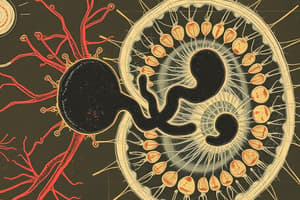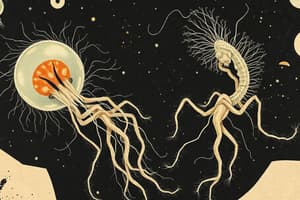Podcast
Questions and Answers
Which mode of division is characteristic of ciliates?
Which mode of division is characteristic of ciliates?
- Schizogony
- Transverse division (correct)
- Binary fission
- Longitudinal division
Cysts are formed by all protozoa during their life cycle.
Cysts are formed by all protozoa during their life cycle.
False (B)
What term refers to the active, feeding, and multiplying stage of most protozoa?
What term refers to the active, feeding, and multiplying stage of most protozoa?
Trophozoite
In the life cycle of Entamoeba histolytica, the formation of a cyst that matures produces four ______.
In the life cycle of Entamoeba histolytica, the formation of a cyst that matures produces four ______.
Match the following protozoan life cycle stages with their descriptions:
Match the following protozoan life cycle stages with their descriptions:
Which of the following represents a method of asexual reproduction in sarcodines?
Which of the following represents a method of asexual reproduction in sarcodines?
Entamoeba histolytica always causes disease in infected individuals.
Entamoeba histolytica always causes disease in infected individuals.
What is the primary habitat for many entozoic amoebas?
What is the primary habitat for many entozoic amoebas?
Amoebas use __________ to aid in locomotion and food capturing.
Amoebas use __________ to aid in locomotion and food capturing.
Match the following amoeba species with their characteristics:
Match the following amoeba species with their characteristics:
Flashcards are hidden until you start studying
Study Notes
Reproduction and Life Cycles of Protozoa
- Division types vary among protozoa: longitudinal in flagellates, transverse in ciliates, and no apparent axis in amebas.
- Schizogony is a common form of asexual division where the nucleus divides multiple times before cytoplasmic division into merozoites.
- Apicomplexans, such as Plasmodium and Toxoplasma, undergo gamogony (production of gametes), fertilization to form a zygote, encystation into oocysts, and sporogony to produce infective sporozoites.
Life Cycle and Hosts
- Protozoans have complex life cycles, some requiring two host species, while others need only one.
- A single infectious protozoan can lead to substantial populations, but host death or immune responses limit reproduction.
- Key life cycle stages include the active trophozoite stage associated with disease and various asexual and sexual stages like merozoites and gametocytes.
Cyst Formation and Excystation
- Certain protozoa can multiply within cysts, leading to more organisms upon excystation; for instance, Entamoeba histolytica can produce four metacystic amebas from one cyst.
- Giardia lamblia also doubles its structures in cyst maturation, leading to the formation of two trophozoites.
Characteristics of Sarcodines and Nutrition
- Sarcodines develop pseudopodia for movement and feeding; they lack a pellicle, with possible multinucleate cytoplasm.
- Nutrition can be holozoic or parasitic, reproducing asexually through binary/multiple fission or spore formation, with rare sexual reproduction.
Key Genera of Amebas
- Endamoeba and Entamoeba are found in human and animal intestines; E. histolytica is notable for causing amebic dysentery, while others like E. coli are non-pathogenic.
- Infection pathways involve cysts from contaminated food/water; symptomatic cases can lead to serious health issues, including liver abscesses.
Orders of Protozoa
- Testacea: Characterized by a shell or test, moving through pseudopodia.
- Foraminifera: Ancient shelled organisms mostly found in oceans; tests made of calcium carbonate, with capturing mechanisms using protoplasmic nets.
Mastigophora Classifications
- Zooflagellates: Unicellular with flagella; many are parasites with binary fission as a common reproduction method.
- Phytomastigina and Zoomastigina: Include groups such as Euglena, with unique features like red eyespots and contractile vacuoles for orientation and osmoregulation.
- Class Volvocaceae: Volvox forms colonies with multiple flagellated cells; reproduction can be asexual or sexual.
Trypanosomatids and Human Diseases
- Trypanosoma species, such as T. gambiense and T. rhodesiense, cause African sleeping sickness, transmitted by tsetse flies.
- T. cruzi is the causative agent of Chagas disease, spread by Triatoma infestans.
- Leishmania species are transmitted by sandflies, leading to visceral leishmaniasis.
Giardia lamblia and Trichomonas
- Giardia lamblia associated with diarrhea; transmitted through fecal contamination and survives in the environment via cysts.
- Various Trichomonas species are symbiotic; T. vaginalis can cause vaginitis in humans through venereal transmission.
Studying That Suits You
Use AI to generate personalized quizzes and flashcards to suit your learning preferences.




